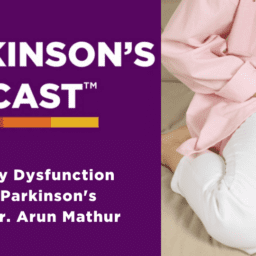If you or someone you know has been diagnosed with Parkinson’s, you may be feeling overwhelmed, devastated, angry, confused or all of the above.
If you suspect you have Parkinson’s, but you haven’t received an official diagnosis, you may be frustrated by the process and wondering what really goes into a diagnosis.
In either case, this podcast episode is for you. In this episode Kelsey Phinney speaks with Dr. Aaron Haug, a neurologist specializing in Parkinson’s at Blue Sky Neurology in Colorado about:
- The diagnostic process for Parkinson’s
- The two most important parts of a Parkinson’s diagnosis
- The difference between a Parkinson’s tremor and an essential tremor
- The symptom differentiation between those diagnosed when they’re young (YOPD) and those diagnosed at older ages
- How to reframe a Parkinson’s diagnoses and take control of your ability to live well with it
Notes
- The two most important parts of the diagnostic process in Parkinson’s are history and physical exam
- The difference between a Parkinson’s tremor and an essential tremor is that a Parkinson’s tremor is a resting tremor. Meaning, even at rest, the hand will shake
- Two-thirds of people with Parkinson’s have a resting tremor
- Ten million people in the US have essential tremor
- Rigidity in Parkinson’s is characterized by stiffness and inflexibility of the limbs, neck or trunk
- The test that can help with assessing a Parkinson’s diagnosis is called a DaTscan
- People who are diagnosed with Parkinson’s before age 50 (YOPD) tend to have more motor symptoms and not as many non-motor symptoms as those who receive the diagnosis later in life
- Out of the one million people in the US who have Parkinson’s, 15% are believed to be the result of a genetic mutation
- YOPD is more likely to be linked to a genetic cause than later onset Parkinson’s
- The earlier you get a diagnosis, the earlier you can begin doing something about it such as working with a specialist who will prescribe medications that will help you and beginning an exercise program that can help you lessen your symptoms and improve your quality of life
- It’s okay to grieve the loss of the expectations you had for your life, but it’s also very possible to live a long and full life with Parkinson’s
Concepts Mentioned in this Podcast & Further Reading

Dr. Haug was born and raised in Kansas. He attended undergraduate at Creighton University and then earned his medical degree at the University of Kansas. He completed neurology residency as well as a fellowship in movement disorders at the University of Colorado, including a year as Chief Resident. His medical interests include Parkinson’s disease, tremor and other movement disorders, as well as deep brain stimulation (DBS) and botulinum toxin injections for the treatment of neurological conditions. Outside the office, he likes to spend time with his wife, run, ski and follow Colorado Rockies baseball.
Thanks for Listening!
To share your thoughts:
- Leave a note in the comment section below.
- Ask a question by emailing us here.
- Share this show on Facebook.
To help out the show:
- Leave an honest review on iTunes. Your ratings and reviews really help, and we read each one.
- Subscribe on iTunes.


















Your production values should be up to your information values! This was a painful “interview” to listen to. Couldn’t you have tried another phone??
Hi Ben – Thank you for listening. We’re sorry it was painful to listen to this interview. We know the sound quality could have been better, and we apologize. We hope the information shared was able to overcome some of that.
Thanks for this informative session. I gleaned several new facts and ideas from it and felt that the summarizations by Kelsey were very beneficial, and especially her personal knowledge of living with a person with Parkinson’s.
Thanks for listening, Dawn. We’re glad you liked it!
Found it helpful to listen more than once. A lot of information that could be divided up with more explaination.
Thanks for the information session and the encouragement that you can live a long time with PD